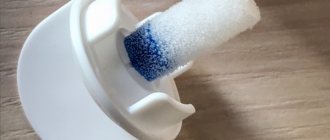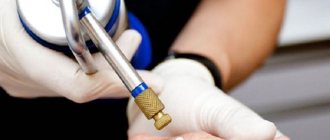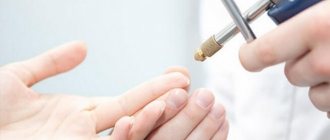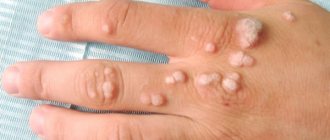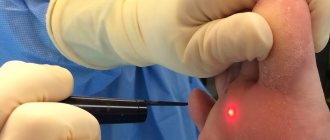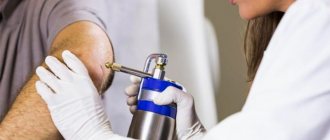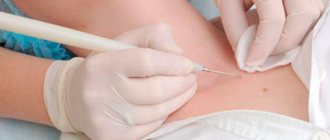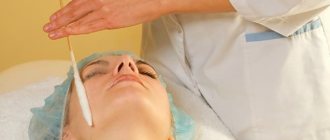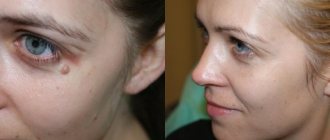An infectious or viral pathogen can easily penetrate into the bloodstream through an injured mole; also, trauma to a nevus is often accompanied by hemorrhage. In addition, there is a risk of a healthy mole degenerating into a pathological neoplasm, so it is better to get rid of some nevi in advance. Since the use of liquid nitrogen practically does not provoke the formation of scars and cicatrices, the removal of moles by this method is widely used in cosmetological and dermatological practice.
Indications for cryodestruction of moles
Individual indications for this procedure are determined by the doctor after examining the nevus using an electron-optical device (dermatoscope). In some cases, to clarify the feasibility of cryodestruction, a preliminary cytological examination of the nevus is performed. The main indications for removing moles with liquid nitrogen are:
- regular injury to the nevus;
- change in color, size or consistency;
- itching, pain, discomfort in the mole area;
- aesthetic considerations.
Cryodestruction has many advantages compared to the method of classical excision and electrocoagulation.
Cost of the procedure
The cost of removing warts with liquid nitrogen is determined by the number of growths on the skin. Sometimes it is necessary to conduct several cryodestruction sessions, which increases the total cost of treatment.
At the Healthy Family clinic, you can remove warts with liquid nitrogen in Moscow. Experienced specialists work with patients, observing infection safety rules. We provide comprehensive and consistently high-quality medical care.
See also:
Cryodestruction
Facial cryomassage
Cryodestruction of tonsils
Removing moles with nitrogen: features of the procedure
Removal of a mole by cryodestruction is carried out using the application of liquid nitrogen. Features of the procedure depend on the type of applicator. If the mole is superficial, it is permissible to use a cotton swab on a wooden stick, which is dipped into a container with a cold substance, after which this cotton swab is applied to the mole for a few seconds. The downside of this procedure will be the risk of damage to healthy tissue surrounding the nevus.
A cylinder filled with a low-temperature substance and having a removable tip can also be used. This procedure is very productive and is practically not accompanied by complications such as injury to nearby tissues, since the balloon is supplied with removable tips of different diameters, which makes it possible to select the appropriate diameter for each specific case. The circumference of the tip should be several millimeters larger than the nevus, this is necessary so that all structures of the nevus are subjected to cold treatment.
The third method of cryodestruction of moles, which is actively used in clinical practice, is the application of a cold substance using an aerosol. When sprayed, the cold jet can hit healthy tissue and damage it. In addition, removal of moles by this method is not used for nevi that are deeply rooted, since destruction may not occur in all structures of the mole.
How does the procedure work?
The mole removal process lasts about 3 minutes, there is no pain, and the patient does not need painkillers. If the procedure is performed on the face, then the specialist needs to be as careful as possible, because there is a risk of damage to the skin.
The faster freezing is performed using liquid nitrogen, the more efficient the entire procedure and recovery stage are. Damaged skin and healthy areas that are located next to the growth are regenerated.
Stages:
- The tissues are frozen and within a few minutes become dense and insensitive.
- Collateral edema then appears and lasts about 3 hours.
- Bubbles appear and disappear after a day.
- Necrosis disappears within 4 weeks.
- Complete regeneration of damaged integument occurs in approximately 4-6 months.
In order for the spraying of liquid nitrogen to be as accurate and effective as possible, you need to contact only good clinics and salons where experienced professionals work. With the right approach, you can get rid of unpleasant moles and warts quite quickly. Absolut Med in the Northern Administrative District of Moscow could be such a clinic for you.
Recovery period after cryodestruction of moles
During the process of cryodestruction of moles, the area that is subjected to cold treatment loses sensitivity and acquires a whitish color. In this case, the patient may experience subjective sensations such as burning or tingling at the site of exposure. There is no significant pain during cryodestruction.
The healing and regeneration period includes the following stages:
- During the first day, an inflammatory process occurs in the area of the treated area, which develops against the background of destruction of nevus tissue. After this, granulation tissue is formed, visually resembling a crust;
- after a week, the process of regeneration of tissue structures in the area of the removed nevus begins (new epithelial tissue appears);
- Complete restoration of tissue elements occurs after a month and a half. At this stage, absolutely healthy tissue appears at the site of cryodestruction, without defects or signs of cold exposure.
Laser Application
A dermatologist can offer the patient several ways to remove tumors. Naturally, the patient will give preference to the one that is the least traumatic and painless. Laser removal of papillomas and warts allows you to quickly get rid of the problem.
The microfractional beam evaporates the growth without affecting healthy tissue. To completely remove the tumor, one procedure is sufficient. There are no scars after using the laser. In addition, blood loss is also excluded.
- Diabetes.
- Blood diseases.
- Oncology.
- Pregnancy.
- Autoimmune diseases.
- Tendency to keloid scars.
- Epilepsy.
After the procedure, the wound heals within two weeks. Many patients who have chosen this method of treatment leave positive reviews on the Internet. The consequences of laser removal of papillomas and moles are clean and healthy skin. Just a few days after the procedure, the patient completely forgets about the eliminated growths. There are no side effects after using the laser.
Care after cryodestruction of moles
The crust that forms during the first day after removal of a mole using cryodestruction prevents the introduction of infectious, viral and other pathogenic microelements into the body. The patient must ensure the preservation of this crust until its physiological rejection occurs. Under no circumstances should this crust be peeled off on your own, since the process of restoration of damaged tissue will be disrupted and a scar may remain in the area that was subjected to cryodestruction. In addition, when the crust is mechanically removed, a wound surface appears, acting as an entrance gate for any infection.
You should not apply cosmetics to the cold-exposed area, and you should also minimize the ingress of water into this area.
If there are pathological changes during the healing period, you must consult a specialist. Symptoms of the pathological course of the rehabilitation period after cryodestruction include:
- local hemorrhage;
- severe swelling of the soft tissues around the wound;
- redness of the skin around the cryodestruction area, which does not decrease, but gradually becomes more widespread;
- the presence of purulent discharge from the wound;
- general hyperthermia, etc.
During the recovery period, it is necessary to exclude exposure to sunlight on the area of the skin that has undergone cryodestruction. To speed up tissue regeneration processes, the doctor may recommend the patient to use wound healing gels. This treatment is only advisable during the first three weeks after the procedure. Some patients may experience itching of the skin in the area where the mole was previously located. For such patients, the use of antipruritic ointments is indicated during the rehabilitation period. It is strictly contraindicated to independently select symptomatic treatment; recommendations on wound care should be given by a doctor, taking into account the individual characteristics of the body and contraindications.
When is it necessary to remove moles?
The first signal that a mole needs to be urgently removed before it causes damage to health is its growth, change in color and shape, as well as bleeding and some pain. It is also worth consulting a doctor if the number of moles on the skin begins to increase rapidly and rapidly. In this case, removing the mole is a radical method of its so-called treatment. In fact, this is the best prevention for the transformation of moles into malignant tumors. But it is worth remembering that any removal of a mole should only occur with the approval and prescription of a doctor, by licensed and qualified specialists.
Possible complications after cryodestruction of moles
After exposure of nevi to liquid nitrogen, the risks of complications are minimal. However, in rare cases, some patients may experience the following complications:
- allergic reaction to cold exposure (with incomplete collection of anamnestic data);
- damage to healthy tissues by liquid nitrogen. This complication may occur if nitrogen removal is performed by a specialist who does not have the appropriate practical skills;
- wound infection after mole removal (failure to follow doctor’s recommendations regarding wound care);
Sometimes, due to failure to follow the rules for caring for the wound surface, a scar forms at the site of the removed mole or pigment spots appear.
Attention!
This article is posted for informational purposes only and under no circumstances constitutes scientific material or medical advice and should not serve as a substitute for an in-person consultation with a professional physician.
For diagnostics, diagnosis and treatment, contact qualified doctors! Number of reads: 1049 Date of publication: 08/27/2018
Dermatologists - search service and appointment with dermatologists in Moscow
Surgical intervention
The safest way is to remove moles and papillomas using a surgeon's scalpel. It is this method that is used if there is a suspicion of malignant degeneration of the growth. The operation is performed using anesthesia, so it is comfortable for the patient. Surgical intervention guarantees complete removal of the tumor, unlike laser or cryodestruction. In addition, the risk of relapse is eliminated. Many patients do not know where to remove papilloma and mole - in a private clinic or a public one. In fact, it all depends on the experience of the surgeon. It is important to find a qualified doctor. As practice shows, most often such specialists work in government agencies.
There are no contraindications to surgical removal of growths. Sometimes it is necessary to postpone the procedure. The doctor will advise you to undergo surgery in the following cases:
- Pregnancy and breastfeeding.
- Exacerbation of herpes.
- Inflammatory process.
- Exacerbation of a chronic disease.
- Viral or bacterial infection.
The duration of the operation usually does not exceed 60 minutes. After excision of the tissue, the doctor applies stitches. If necessary, the removed nevus or papilloma is sent for histological examination. The wound is treated with an antiseptic daily. Do not remove the resulting crust yourself. In addition, the affected area must be protected from exposure to sunlight for two to three months. Non-absorbable sutures are removed 10 days after the intervention. A barely noticeable scar remains after the operation. If the neoplasm was located quite deep, a more pronounced mark may remain. You can smooth it out using a special patch or absorbable cream.
What to do after removing a wart with liquid nitrogen
The final result after wart removal largely depends on how well the subsequent care was organized. After all, the skin receives quite serious damage during treatment with liquid nitrogen. To ensure the best healing, you need to follow these recommendations:
- After a blister appears, it must be carefully protected from damage and under no circumstances should it be punctured. If warts were removed in areas of possible rubbing with clothing, then any contact with the blisters should be avoided. If their integrity is violated, there is a high probability of infection, suppuration, and the formation of scars.
- Twice a day, blisters are treated with a solution of salicylic alcohol (2%) or potassium permanganate. This speeds up the crust formation process and provides additional protection against infections.
- It is forbidden to cover blisters with adhesive tape, as they may stick to them and cause damage. If there is a need to cover them, then you need to use loose gauze bandages or secure special gauze napkins with a band-aid, but on healthy skin.
- Blisters can be soaked with water, i.e. Showering is allowed. But you can’t rub them with a sponge or towel (just blot them gently).
- To care for blisters, scabs and skin, you should use only those products prescribed by your dermatologist. Self-medication is unacceptable.
- If severe pain occurs after the removal procedure, you can take painkillers.
If any changes are noticed on the skin that the doctor did not warn about, then you should definitely contact him for help. Usually, removing warts with nitrogen does not cause complications, but the treated areas must be carefully looked after.
Cryodestruction of skin tumors
Guidelines
Based on the clinical diagnosis, cryogenic removal of skin tumors was performed. The cryodestructive effect was achieved by contact method using multiple freezing cycles.
The diameter of the applicator nozzle was selected according to the tumor, overlapping it by 2-3 mm.
Exposure time depended on the size of the tumor, its location and histological structure.
When treating tumors with a predominance of hyper- and parakeratosis and the presence of underlying fibrous tissue, cryodestruction had to be repeated 2-3 times with a total time dosage of up to 7-10 minutes.
If the tumor was localized in the mucous membranes with a predominance of papillomatosis, then 1 session of cryodestruction with a total time dosage of 1-2 minutes was often sufficient.
After the procedure, it was recommended to treat the area of cryotherapy with an alcohol solution of brilliant green, and in the stage of scab formation - with sea buckthorn oil. need for anesthesia during cryodestruction .
Clinically, immediately after cryodestruction , the formation of an ice field exceeding the diameter of the applicator nozzle by 1-2 mm was observed.
As it thawed, hyperemia developed. After 40-60 seconds. after cryotherapy, edema developed, a more pronounced reaction was observed in areas with abundant subcutaneous fat; then, after 2-5 hours, a papule with serous or serous-hemorrhagic contents formed, which opened on days 2-5, forming a wound surface.
Swelling gradually regresses over the first 5 days.
By 3-7 days a dense crust has formed, healing proceeds under the scab from the periphery to the center.
By the end of 3-4 weeks, the scab is rejected, leaving behind a delicate pink scar, which is invisible 2-3 months after treatment. The effectiveness of treatment for benign tumors was achieved in 98% of cases.
Cryodestruction of basal cell skin cancer.
The clinical diagnosis of basal cell skin cancer was verified histologically or cytologically. The fundamental difference in the method of cryodestruction of skin cancer from a benign formation was that:
1) the diameter of the applicator nozzle was selected to overlap the tumor by 0.5 cm;
2) the total time of one cryodestruction was 3-5 minutes. with 2-fold freezing (single freezing-thawing may not be lethal for all cells of a malignant neoplasm, unless a temperature below -50 degrees C was created in the entire volume of the tumor). The time of cryotherapy for various skin tumors is presented in table. 1
.
3) the number of treatment cycles depends on the size of the tumor ( Table 2
).
Time of cryotherapy for various skin tumors.
Table 1
| Name of tumor | Exposure time (sec.) |
| 1. Pigmented tumors | |
| intradermal nevus | 180 |
| border nevus | 180 |
| mixed nevus | — |
| 2. Warts | |
| plantar | 180 |
| ordinary | 240-300 |
| genital warts | 40-60 |
| other | — |
| 3. Papillomas | 120-180 |
| 4. Leukolplakia | 60-120 |
| 5. Basal cell carcinoma stage 1-2. | |
| surface form | 180-240 |
| nodular form | 240-300 |
| ulcerative form | 240-300 |
| other | 240-300 |
The number of cryosurgery sessions depending on the size of the tumor.
table 2
| Tumor size (cm.) | Number of sessions |
| 1. to 1 | 1 |
| 2. 1-2 | 2 with inter. in 10-15 days. |
| 1. 2-3 | 2-3 s inter. in 10-15 days. |
Radicality control was carried out as follows: during the healing process, scrapings were taken from the cryodestruction on days 3 and 10 for cytological examination to identify tumor cells.
After the procedure, it was recommended to treat the area of cryodestruction There was no need for anesthesia during cryotherapy.
From the moment the scab forms, patients in most cases become able to work.
Long-term results were monitored in patients over a period of 4 months. up to 5 years.
Tumor relapses occur in 2% of cases. The occurrence of relapses is associated with errors in the cryodestruction , since both observations occurred at the initial stage of work.
Complications.
Complications include suppuration under the scab. It occurs in 2-3 out of 100 treated patients.
In case of suppuration, it is necessary to remove the crust, treat the surface of the wound with hydrogen peroxide and bandage it with a hypertonic solution.
As the wound cleanses and granulations appear, you should switch to ointment dressings.
With this complication, there is a prolongation of the repair period and the appearance of rough scarring.
The method of cryogenic treatment of benign and malignant skin formations is simple, effective, gives good cosmetic results, is economical and can be used with simple equipment in a clinic, district, or local hospitals.
